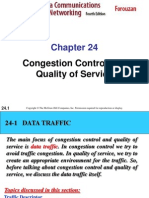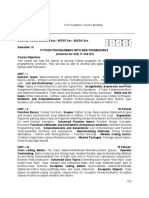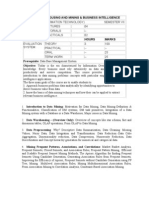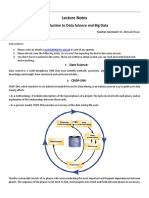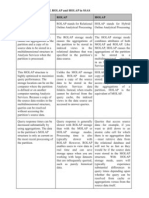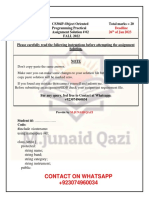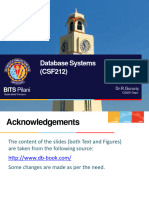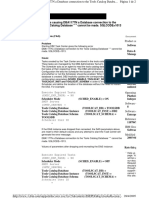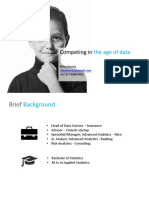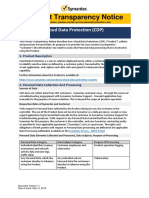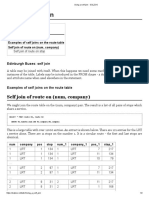Bi Unit1
Uploaded by
J.K. TechnologyBi Unit1
Uploaded by
J.K. TechnologyMIT School of Computing
Department of Information Technology
Fourth Year Engineering
18BTDA736- Professional Elective-III: Business
Intelligence
Class - L.Y.PLD
(SEM-VII)
Unit - I
IMPORTANT CONCEPTS
AY 2023-2024 SEM-VII
1
MIT School of Computing
Department of Information Technology
Unit-I Syllabus
Introduction to Data, Information, and Knowledge, Design and
implementation aspect of OLTP, Introduction to Business
Intelligence and Business Models, Design and implementation
PLD
aspect of OLAP/Data Warehouse, BI Definitions & Concepts,
Business Applications of BI, Role of DW in BI, BI system
components, Components of Data Warehouse Architectures.
2
Introduction to data, information and
Knowledge
• Terminologies:
• It has been a long-held belief by many philosophers that knowledge is
power and that knowledge stems from understanding of information;
information, in turn, is the assigning of meaning to data.
• To develop the understanding of information technology, we start by
defining these three related concepts. The topics are hierarchical in that:
Informati Knowledg
Data
on e
3
Introduction to data, information and
Knowledge
• Terminologies:
1. Data:
The concept of data as it is used in the syllabus is commonly referred
to as ‘raw’ data – a collection of text, numbers and symbols with no
meaning. Data therefore must be processed, or provided with a context,
before it can have meaning.
• Example
• 3, 6, 9, 12
• Cat, dog, gerbil, rabbit
• 161.2, 175.3, 166.4, 160.5
These are meaningless sets of data. They could be the first four answers in
the 3x table, a list of household pets and the heights of 15-year-old students
but without a context we don’t know.
4
Introduction to data, information and
Knowledge
• Terminologies:
2. Information:
It is to learn the concept of what ‘information’ is as used in information
technology.
Information is the result of processing data, usually by computer. This
results in facts, which enables the processed data to be used in context
and have meaning. Information is data that has meaning.
• When does data become information?
Informati
Data
on
5
Introduction to data, information and
Knowledge
• Terminologies:
2. Information:
• When does data become information?
• Data on its own has no meaning. It only takes on meaning and
becomes information when it is interpreted. Data consists of raw facts
and figures. When that data is processed into sets according to context,
it provides information.
• Data refers to raw input that when processed or arranged makes
meaningful output. Information is usually the processed outcome of
data. When data is processed into information, it becomes interpretable
and gains significance.
6
Introduction to data, information and
Knowledge
• Terminologies:
2. Information:
• When does data become information?
• In IT, symbols, characters, images, or numbers are data. These are the
inputs an IT system needs to process in order to produce a meaningful
interpretation.
• In other words, data in a meaningful form becomes information.
Information can be about facts, things, concepts, or anything relevant
to the topic concerned. It may provide answers to questions like who,
which, when, why, what, and how.
` Data meaning
Informati
on
7
Introduction to data, information and
Knowledge
• Terminologies:
2. Information:
• Example:
Look at the following examples given for data:
• 3, 6, 9, 12
• cat, dog, gerbil, rabbit
• 161.2, 175.3, 166.4, 164.7, 169.3
Only when we assign a context or meaning does the data become
information. It all becomes meaningful when we are told:
• 3, 6, 9 and 12 are the first four answers in the 3x table.
• cat, dog, gerbil, rabbit is a list of household pets.
• 161.2, 175.3, 166.4, 164.7, 169.3 are the heights of 15-year-old 8
students.
Introduction to data, information and
Knowledge
• Terminologies:
3. Knowledge:
When someone memorizes information, this is often referred to as ‘rote-
learning’ or ‘learning by heart’. We can then say that they have acquired
some knowledge. Another form of knowledge is produced as a result of
understanding information that has been given to us and using that
information to gain knowledge of how to solve problems.
Knowledge can therefore be:
• Acquiring and remembering a set of facts or
• The use of information to solve problems.
9
Introduction to data, information and
Knowledge
• Terminologies:
3. Knowledge:
The first type is often called explicit knowledge. This is knowledge that can
be easily passed on to others. Most forms of explicit knowledge can be stored
in certain media. The information contained in encyclopedias and textbooks
are good examples of explicit knowledge.
The second type is called tacit (implicit) knowledge. It is the kind of
knowledge that is difficult to pass on to another person just by writing it
down. For example, saying that Paris is the capital of France is an explicit
knowledge that can be written down, passed on, and understood by
someone else.
However, the ability to speak a foreign language, bake bread, program a
computer or use complicated machinery requires additional pieces of
knowledge (such as that gained through experience) that are not always
10
known explicitly and are difficult to pass on to other users.
Introduction to data, information and
Knowledge
• Terminologies:
3. Knowledge:
How are data, information and Knowledge linked?
Informati Applicatio Knowledg
on n or use e
If we put Knowledge into an equation it would look
like this
11
Introduction to data, information and
Knowledge
• Terminologies:
3. Knowledge:
• Example:
Look at the following examples given for data:
• 3, 6, 9, 12
• cat, dog, gerbil, rabbit
• 161.2, 175.3, 166.4, 164.7, 169.3
Only when we assign a context or meaning does the data become
information. It all becomes meaningful when we are told:
• 3, 6, 9 and 12 are the first four answers in the 3x table.
• cat, dog, gerbil, rabbit is a list of household pets.
• 161.2, 175.3, 166.4, 164.7, 169.3 are the heights of 15-year-old
students. 12
Introduction to data, information and
Knowledge
• Terminologies:
3. Knowledge:
• Example:
If we now apply this information to gain further knowledge, we could say
that:
• 4, 8, 12 and 16 are the first four answers in the 4x table (because the
3x table starts at three and goes up in threes the 4x table must start at
four and go up in fours)
• The tallest student is 175.3cm.
• A lion is not a household pet as it is not in the list, and it lives in the
wild.
13
Introduction to data, information and
Knowledge
• Activities:
1. Differentiate data, information and Knowledge.
2. Describe how data becomes knowledge.
3. 5, 10, 15, 20 are items of data. Explain how these could become
information and what knowledge could be gained from them.
14
Design and implementation aspect of
OLTP
• OLTP: (online transaction processing) (analytical processing)
• OLTP or online transactional processing is a software program or operating
system that supports transaction-oriented applications in a three-tier
architecture. It facilitates and supports the execution of many real-time
transactions in a database.
• OLTP monitors daily transactions and is typically done over an internet-
based multi-access environment. It handles query processing and, at the
same time, ensures and protects data integrity.
• The efficacy of OLTP is determined by the number of transactions per
second that it can process. OLTP systems are optimized for transactional
superiority hence, suitable for most monetary transactions.
15
Design and implementation aspect of
OLTP
• OLTP:
• OLTP systems activities consist of gathering input data, processing the
data, and updating it using the collected data. OLTP is usually supported by
a database management system (DBMS) and operates in a client-server
system. It also relies on advanced transaction management systems to
facilitate multiple concurrent updates.
16
Design and implementation aspect of
OLTP
• OLTP transaction real-time applications:
• OLTP systems facilitate many types of financial and non-financial
transactions such as:
•Automated teller machines (ATMs)
•Online banking applications
•Online bookings for airline ticketing, hotel reservations, etc.
•Online and in-store credit card payment processing
•Order entry
•E-commerce and in-store purchases
•Password changes and sending text messages
17
Design and implementation aspect of
OLTP
• OLTP transaction real-time applications:
• Let's consider the ATM example here:
Assume that a couple has a joint account with a bank. One day both simultaneously
reach different ATM centers at precisely the same time and want to withdraw the
total amount present in their bank account.
However, the person that completes the authentication process first will be able to
get money. In this case, the OLTP system makes sure that the withdrawn amount
will be never more than the amount present in the bank. That means, OLTP
systems are optimized for transactional superiority instead of data analysis.
18
Design and implementation aspect of
OLTP
• Characteristics of OLTP :
1. Short response time
OLTP systems maintain very short response times to be effective for
users. For example, responses from an ATM operation need to be quick
to make the process effective, worthwhile, and convenient
2. Process Small Transactions:
OLTP systems support numerous small transactions with a small amount
of data executed simultaneously over the network. It can be a mixture
of queries and Data Manipulation Language (DML) overload. The queries
normally include insertions, deletions, updates, and related actions.
Response time measures the effectiveness of OLTP transactions, and
millisecond responses are becoming common. 19
Design and implementation aspect of
OLTP
• Characteristics of OLTP :
3. Data Maintenance Operations
Data maintenance operations are data-intensive computational
reporting and data update programs that run alongside OLTP systems
without interfering with user queries.
4. High-level transaction volume and multi-user access
OLTP systems are synonymous with many users accessing the same
data at the same time. Online purchases of a popular or trending gadget
such as an iPhone may involve an enormous number of users all vying
for the same product. The system is built to handle such situations
expertly.
20
Design and implementation aspect of
OLTP
• Characteristics of OLTP :
5. Very high concurrency
An OLTP environment experiences very high concurrency due to the
large user population, small transactions, and very short response
times. However, data integrity is maintained by a concurrency
algorithm, which prevents two or more users from altering the same
data at the same time. It prevents double bookings or allocations in
online ticketing and sales, respectively.
A mobile money transfer application is a good example where
concurrency is very high as thousands of users can be making transfers
simultaneously on the platform at every time of the day.
21
Design and implementation aspect of
OLTP
• Characteristics of OLTP :
6. Round-the-clock availability
OLTP systems often need to be available round the clock, 24/7, without
interruption. A small period of unavailability or offline operations can
significantly impact many people and an equally huge transaction quantity.
Downtimes can also pose potential losses to organizations, e.g., an
online banking system downtime has adverse consequences to the
bank’s bottom line. Therefore, an OLTP system requires frequent, regular,
and incremental backup.
7. Indexed data sets
Index data sets are used to facilitate rapid query, search, and
22
retrieval.
Design and implementation aspect of
OLTP
• Characteristics of OLTP :
8. Data usage patterns
OLTP systems experience periods of both high data usage and low data
usage. Finance-related OLTP systems typically see high data usage
during month ends when financial obligations are settled.
9. Normalized Schema
OLTP systems utilize a fully normalized schema for database
consistency. That means it helps us to reduce data redundancy and
improve data integrity.
10. Storage
OLTP stores data records for the past few days or about a week. It 23
supports sophisticated data models and tables.
Design and implementation aspect of
OLTP
• Architecture of OLTP
1. Business Strategy
The business strategy influences the OLTP
systems design. The strategy is
formulated at the senior management and
the level of the board of directors.
2. Business Process
They are processes by the OLTP system
that will accomplish the goals set by the
business strategy. The processes
comprise a set of activities, tasks, and
actions.
3. Product, customer, Orders,
transactions
The OLTP database contains information
on products, transactions, employees, and Basic OLTP architecture in collaboration with
24
customers, and suppliers. OLAP
Design and implementation aspect of
OLTP
• Architecture of OLTP :
4. Extract, Transform, Load (ETL) process
The ETL process extracts data from the OLTP database and transforms it
into the staging area, which includes data cleansing and optimizing the
data for analysis. The transformed data is then loaded into the online
analytical processing (OLAP) database, which is synonymous with the
data warehouse environment.
5. Data Warehouse and Data Mart
Data warehouses are central repositories of integrated data from one or
more incongruent sources. A data mart is an access layer of the data
warehouse that is used to access specific/summarized information of a
unit or department.
6. Data mining, analytics and decision Making
25
The data stored in the data warehouse and data mart is used for
analysis, data mining, and decision making.
Design and implementation aspect of
OLTP
• System design aspect of OLTP:
The defining characteristics of OLTP transactions are atomicity and
concurrency. Concurrency prevents multiple users from changing the same
data simultaneously. Atomicity (or indivisibility) ensures that all
transactional steps are completed for the transaction to be successful. If
one step fails or is incomplete, the entire transaction fails.
Atomic statefulness is a computing condition in which database changes are
permanent, requiring transactions to be completed successfully. OLTP
systems enable inserting, deleting, changing, and querying data in a
database.
26
Design and implementation aspect of
OLTP
• System design Elements Comment
aspect of OLTP: Rollback It is a part of DB that record transactions in case one is rolled
Therefore, segment back. They provide read consistency, database recovery and
designing an OLTP transaction rollback.
system requires Discrete They defer changes to the data until a transaction is
knowing its base transaction committed.
characteristics Clusters A cluster is a schema that contains one or more tables with
such as atomicity, columns.
concurrency, and Data block size It should be within the maximum limit, it avoids unnecessary
integrity and I/O
avoiding excessive
Buffer cache size To avoid unnecessary resource consumption, SQL statements
use of clusters and should be tuned to use the database buffer cache
indexes. The
following factors Dynamic Dynamic allocation of space to tables and rollback segments.
allocation
should be
considered in OLTP Database Partitioning the database increases performance of sites that
design. partitioning have frequent transactions, at the same time maintaining
security and availability.
Database tuning OLTP can maximize performance swiftly and effectively. 27
Design and implementation aspect of
OLTP
• Activity
• Define the Benefits of OLTP systems.
• Define the Drawbacks of OLTP systems.
28
Introduction to BI and Business Models
• What is Business Intelligence?
• If you want to track the term back in years, well it goes way back in
1989 when Howard Dresner defined it.
• According to Mr. Dresner of the Gartner group, a set of concepts
and methodologies to improve decision making in business trough
use of facts and fact-based systems.
• The main goal of BI is to improve decision making.
• And it is a fact-based systems, that means decisions are no longer
made on gut feeling or purely on guesses or on hunch. It must be
backed by facts.
29
Introduction to BI and Business Models
• What is Business Intelligence?
• The other task of BI is to mine information to provide some knowledge
and apply that knowledge to provide beneficial insights.
• the insights then lead to impactful decision making which in turn provides
business benefits such as increased profitability, increased productivity,
reduced costs, improved operations, etc.
Knowledg
Informatio
Raw Data e
n
Discovery
Business Impactful Beneficial
Benefits Decisions Insights
30
Introduction to BI and Business Models
• What was there before BI?
• Even before the BI evolution, the decision makers invest in obtaining the
market facts and internal functions such as finance and marketing sales
to evolve business strategies and plans.
• They would usually invest in Market research (some companies still do
invest in market research). Market research would help them to
understand better marketplace in which the enterprise is operating or
would want to see a future growth.
• Enterprises also employ third-party agencies to conduct market surveys
or consumer surveys and competitive analysis. They also use
benchmark data to understand their strengths, and specific market
opportunities they could exploit as well as risks that might their revenue
or market share. 31
Introduction to BI and Business Models
• Characteristics of Business Intelligence
• Single version of truth
• Multiple perspective on same problem
• Geographical independence
• Fact-based decision.
32
Introduction to BI and Business Models
How Business Intelligence Works?
• A business intelligence architecture includes more than just a BI
software. Business intelligence data is typically stored in a data
warehouse built for an entire organization or in smaller data
marts that hold subsets of business information for individual
departments and business units, often with ties to an enterprise
data warehouse.
• After having the data in our hands, BI process usually
includes
• Data preparation
• Analytical solutions
• Distribution of key performance indicators and related findings 33
Introduction to BI and Business Models
How Business Intelligence Works?
A typical BI Architecture
34
Introduction to BI and Business Models
How Business Intelligence Works?
35
Introduction to BI and Business Models
Business Models
• It is important to understand business model while you try to
solve a business problem. If you understand the business
model it will help you to ask the right questions to the
stakeholders, to design a systematic planning and research
and help you to discover some meaningful insights.
• What is a business model?
A business model usually answers the following
questions:
• What product/service a company will sell?
• How it intends to market that product or service?
• What kind of expenses it will face?
36
• How it expects to turn a profit?
Introduction to BI and Business Models
Business Models
• While choosing a business model, following key points should be
considered:
• Value proposition : Product should be attractive to customers
• Target market: A group of consumers such as particular firms or
product specific organization would be interested in the product.
• Competitive advantage: Immutable product’s characteristics.
• Cost structure: Expenditure required to function the business.
• Key metrics: Measurement for Success.
• Resources: The physical, financial and intellectual assets of the
organization.
• Problem solving: Strategies for solving customer’s problems.
• Revenue model: The multiple ways your company can generate
income. 37
• Profit margin: The amount your revenue exceeds business costs.
Introduction to BI and Business Models
Business Models
• Most well-known types of business models.
• Subscription model
• Freemium model
• Product to service model
• Crowdsourcing model
• Franchise model
• Distribution model
• Manufacturer model
• Retailer model.
38
Design and Implementation aspects of
OLAP/DW
Overview of OLAP
• In 2nd chapter we saw the design aspects of OLTP and within that we
also saw how OLTP is linked to OLAP. OLAP is in fact the technology
behind many BI applications.
• On-Line Analytical Processing (OLAP) is a decision support tool that allows
users to analyze different dimensions of multidimensional data.
• OLAP structures data hierarchically to reflect the real dimensionality of the
enterprise as understood by the users. Users can pivot, filter, drill down and drill
up data and generate numbers of views with simple mouse manipulations. It is
commonly used in business reporting for sales, marketing, management, data
mining, and similar areas. 39
Design and Implementation aspects of
OLAP/DW
• An OLAP structure created from the operational data
is called an OLAP cube. Following figure shows, the
cube holds data more like a 3D spreadsheet rather
than a relational database, allowing different views of
the data to be quickly displayed.
• In multidimensional OLAP (MOLAP) databases,
cubes are created and stored physically, whereas in
relational OLAP (ROLAP) databases, cubes are
virtually created, based on a star or snowflake
schema
40
Design and Implementation aspects of
OLAP/DW
• E. F Codd coined the term OLAP and based the principles defined by E. F
Codd, following are the 12 rules that OLAP technologies/
implementation must support.
• Multidimensional conceptual view: Must support EIS (Executive Information
System) slice and dice operations and is usually required in financial modeling.
• Transparency: Is part of an open system that supports heterogeneous data sources.
Furthermore, the end user should not be concerned about the details of data access
or conversions.
• Accessibility: Presents the user with a single logical schema of the data. OLAP
engines act as middleware, sitting between heterogeneous data sources and an
OLAP front-end.
• Consistent reporting performance: Performance should not degrade as the number
of dimensions in the model increases.
• Generic dimensionality: Not limited to 3-D and not biased toward any dimension. A
41
function applied to one dimension should also be able to be applied to another.
Design and Implementation aspects of
OLAP/DW
• Client/server architecture: Requires open, modular systems. Not only the product
should be client/server but the server component of an OLAP product should allow
that various clients could be attached with minimum effort and programming for
integration.
• Dynamic sparse-matrix handling: Related both to the idea of nulls in relational
databases and to the notion of compressing large files, a sparse matrix is one in
which not every cell contains data. OLAP systems should accommodate varying
storage and data-handling options.
• Multiuser support: Supports multiple concurrent users, including their individual
views or slices of a common database.
• Unrestricted cross-dimensional operations: All dimensions are created equal, so
all forms of calculation must be allowed across all dimensions, not just the measures
dimension.
42
Design and Implementation aspects of
OLAP/DW
• Intuitive data manipulation: Users shouldn't have to use menus or perform complex
multiple step operations when an intuitive drag and drop action will do.
• Flexible reporting: Users should be able to print just what they need, and any
changes to the underlying model should be automatically reflected in reports.
• Unlimited dimensional and aggregation levels: Supports at least 15, and preferably
20, dimensions.
43
Design and Implementation aspects of
OLAP/DW
OLAP Architectures:
• Regardless of the different types, all OLAP architectures
involve building a multidimensional data structure (cubes),
where dimensions represent business entities such as sales
regions and products or natural entities such as time and
geography.
• Using multidimensional databases can present their data
for an application using two types of cubes: hypercube and
multicubes.
• In a hypercube, as shown in figure, all data appears logically
as a single cube. All parts of the manifold represented by this
hypercube have identical dimensionality. Each dimension
belongs to one cube only. A dimension is owned by the
hypercube. This simplicity makes easy for users to
44
understand.
Design and Implementation aspects of
OLAP/DW
OLAP Architectures:
• Designing a hypercube model is a top-down process with three major steps:
1. decide which process of the business you want to capture in the model, such as
sales activity.
2. identify the values that you want to capture, such as sales amounts. This
information is always numeric
3. identify the granularity of the data, meaning the lowest level of detail at which you
want to capture. These elements are the dimensions
45
Design and Implementation aspects of
OLAP/DW
OLAP Architectures:
• In the multicube model, data is segmented into a set of
smaller cubes, each of which is composed of a subset of the
available dimensions, as shown in Figure. They are used to
handle multiple fact tables, each with different dimensionality.
• A dimension can be part of multiple cubes. Dimensions
are not owned by any one cube, like under the hypercube
model. Rather, they are available to all cubes, or there can be
some dimensions that do not belong to any cube.
• This makes it much more efficient and versatile. It is also a
more efficient way of storing very sparse data, and it can
reduce the pre-calculation database explosion effect.
46
Design and Implementation aspects of
OLAP/DW
OLAP Architectures:
• When and how is the multidimensional data structure constructed?
• Some OLAP technologies require an ETL (extract, transform, and load) process,
which typically runs at off-peak usage times to build and update a persistent
multidimensional data structure.
• On the other hand, other OLAP technologies access source data directly to build
and present multidimensional data on the fly as the user performs analysis.
47
Design and Implementation aspects of
OLAP/DW
OLAP Architectures:
• Where does the multidimensional data structure live and how persistent is it?
The multidimensional data structure may reside in a persistent, dedicated multidimensional
database, a hypercube temporarily cached in memory, or a star schema/snowflake schema
stored in a relational database.
48
Design and Implementation aspects of
OLAP/DW
OLAP Architectures:
• OLAP comes in various types or format such as
1. MOLAP (Multidimensional OLAP).
Multidimensional On-Line Analytical Processing (MOLAP) is the more traditional way of
OLAP analysis, in which, data is stored in a multidimensional cube. This allows users to
view different aspects of data aggregates such as sales by time period, geography, or
product. (A relational database is not used for storage)
MOLAP processes data that is already stored in a multidimensional array in which all
possible combinations of data are reflected, each in a cell that can be accessed
directly.
MOLAP is a good choice when data is needed frequently and for rapid query response.
49
Design and Implementation aspects of
OLAP/DW
OLAP Architectures:
1. MOLAP (Multidimensional OLAP)
MOLAP is a two-tier, client/server architecture. The
multidimensional database serves as both the
database layer and the application logic layer.
database layer is responsible for all data storage,
access, and retrieval processes while the
application logic layer is responsible for the
execution of all OLAP requests.
The presentation layer integrates with the The client/server architecture allows
application logic layer and provides an interface
multiple users to access the same
through which the users view and request OLAP
analyses. multidimensional database.
50
Design and Implementation aspects of
OLAP/DW
OLAP Architectures:
1. MOLAP (Multidimensional OLAP)
In MOLAP, the data must be stored multidimensionally to be viewed multidimensionally.
Data from various operational systems is loaded into a multidimensional database
through a series of batch routines. Once this atomic data has been loaded into the
multidimensional database, the general approach is to perform a series of calculations in
batch to aggregate along the dimensions and fill the multidimensional array structures.
Then indices are created, and hashing algorithms are used to improve query access time.
When users request OLAP reports through the interface, the application logic layer of the
multidimensional database retrieves the stored data. It reads the pre-compiled data and
has limited capabilities to dynamically create aggregations or to calculate metrics that have
not been pre-calculated and stored.
51
Design and Implementation aspects of
OLAP/DW
OLAP Architectures:
2. ROLAP (Relational OLAP)
Relational On-Line Analytical Processing (ROLAP) performs dynamic multidimensional
analysis of data stored in a relational database, rather than in a multidimensional database.
The design may be structured in the form of a star or its variations. A typical use of ROLAP
is for large data size that is infrequently queried, such as historical data.
ROLAP accesses data stored in a data warehouse (relational database) to provide OLAP
analyses.
52
Design and Implementation aspects of
OLAP/DW
OLAP Architectures:
2. ROLAP (Relational OLAP)
ROLAP is a three-tier, client/server architecture.
The database layer utilizes relational databases
for data storage, access, and retrieval processes.
The application logic layer is the ROLAP engine
which executes the multidimensional reports from
multiple users.
The ROLAP engine integrates with a variety of
presentation layers, through which users perform
OLAP analyses.
53
Design and Implementation aspects of
OLAP/DW
OLAP Architectures:
2. ROLAP (Relational OLAP)
After defining the data model for the data warehouse, data from OLTP systems is loaded
into the database. Database routines are run to aggregate the data, if required by the data
model. Then indices are created to optimize query access time. Users submit
multidimensional analyses to the ROLAP engine, which then dynamically transforms the
requests into SQL execution plans.
The SQL is submitted to the relational database for processing, the relational query results
are cross-tabulated. A multidimensional result set is returned to the users. It can utilize pre-
calculated results when they are available, or dynamically generating results from atomic
information when necessary.
The ROLAP architecture was invented to directly access data from data warehouses,
thereby supporting optimization techniques to meet batch window requirements and
providing fast response time. These optimization techniques include application-level table 54
partitioning, aggregate inferencing, denormalization support, and multiple fact table joins.
BI system components and
concepts Business layer
In BI framework there are usually four
components:
1. Business layer
Administration and
operation layer
2. Administration and operation layer
3. Implementation layer
Implementation
55
Layer
BI system components and concepts
1. Business Layer
In Business layer there are four components included
a) Business Requirements: The requirements of a business are mapped using following
three processes.
Business Drivers : Responsible for initiating the need to act. For instance, changing
workforce, changing labor laws, change in economy, rules and regulations and technology
Business goals: Responsible for making sure that the targets to be achieved in response
to the drivers. For instance, increased productivity, improved market share, improved profit
margins, improved customer satisfaction and cost reduction.
Business Strategies: The planned course of actions that will help achieve the defined
goals For instance, global deliver model, finding proper partnerships, customer and
56
employee retention programs etc.
BI system components and concepts
1. Business Layer
In Business layer there are four components included
b) Business Value: When a strategy is implemented against certain business goals, then
certain costs (monetary, time, effort, information produced by data integration and
analysis, application of knowledge from experience, etc.) are involved. However, the
final output of the process should create such value for the business whose ratio to the
costs involved should be a feasible ratio.
The business value can be measured in the terms of ROI (Return on Investment), ROA
(Return on
Assets), TCO (Total Cost of Ownership), TVO(Total Value of Ownership),
57
BI system components and concepts
1. Business Layer
In Business layer there are four components included
b) Business Value:
Return on Investment (ROI) : Consider you are working for a company which has an
online community platform that allows their prospective clients to engage with their users
and for this operation your company are using social media platforms to help get news
clients and to increase the number of prospects leads. They attribute 10% of their daily
revenue to social media. So, this will be the return on investment from social media.
Return on Asset (ROA) : ROA is the earning form the invested capital or asset. Consider
your company has a net income of $1 million and has total assets of $5 million. Then its
ROA is 20%. ROAs over 5% are generally considered good and over 20% excellent.
58
BI system components and concepts
1. Business Layer
In Business layer there are four components included
b) Business Value:
Total Cost of Ownership (TCO): TCO defines the cost of owning a business from the time
of purchase / formation by the owner, through its operation and maintenance to the time it
leaves the possession of the owner.
Total Value of Ownership (TVO) : TVO has replaced the simple concept of Owner's Equity
in some companies. It could include a variety of subcategories such as stock, undistributed
dividends, retained earnings or profit, or excess capital contributed. (benefits of alternative
investments)
59
BI system components and concepts
1. Business Layer
In Business layer there are four components included
c) Program Management
Project management ensures that people, projects and priorities work in a way individual
processes are compatible with each other to ensure seamless integration and smooth
functioning of the entire program. It mainly focuses on the following:
• Business priorities • Infrastructure.
• Mission and goals
• Strategies and risks
• Multiple projects
60
BI system components and concepts
1. Business Layer
In Business layer there are four components included
d) Development
The process of development consists of
• Database/data-warehouse development which consist of ETL, data profiling, data
cleansing and database tools.
• Data integration system development which contains data quality tools and data
integration tools.
• Business analytics development which contains processes and various technologies
used.
61
BI system components and concepts
2. Administration and Operation Layer
In Administration and operation layer there four components :
a) Bi Architecture:
Bi architecture defines that data should follow design standards, it must
have a logically suitable data model and it’s metadata should be of high
standards
During Integration process, certain processing standards have to be
followed and should perform according to business semantics and rules.
Data must be consistent. 62
BI system components and concepts
2. Administration and Operation Layer
In Administration and operation layer there four components :
a) Bi Architecture:
Information derived from the data that has been integrated should be
usable, findable and as per the requirements.
Technology used for deriving information must be accessible, it should
have a good UI and should support analysis, decision support, data and
storage management.
Organization must consist of different roles and responsibilities, like 63
management, development, support and usage roles.
BI system components and concepts
2. Administration and Operation Layer
In Administration and operation layer there four components :
b) BI and DW operations: Data Warehouse (DW) administration requires the usage
of various tools to monitor the performance and usage of the warehouse and perform
administrative tasks on it. Some of these tools would be:
• Backup and restore
• Security
• Configuration management
• Database management
64
BI system components and concepts
2. Administration and Operation Layer
In Administration and operation layer there four components :
c) Data resource administration
In general data resource administration involves:
data governance and metadata management.
65
BI system components and concepts
2. Administration and Operation Layer
c) Data resource administration
Data Governance : In data governance, techniques for controlling data
quality, which is used to assess, improve, manage and maintain information
are defined. In helps to define standards that are required to maintain data
quality. Data governance includes following roles:
• Data ownership: Data owners are either individuals or teams who
make decisions such as who has the right to access and edit data and
how it is used. Owners may not work with their data every day but are
responsible for overseeing and protecting data domain.
66
BI system components and concepts
2. Administration and Operation Layer
c) Data resource administration
Data Governance :
• Data stewardship: It is the collection of practices that ensures, and
organization’s data is accessible, usable , safe and trusted. It includes
overseeing every aspect of the data lifecycle: creating, preparing,
using, storing, archiving, and deleting data, in accordance with an
organization’s established data governance principles for promoting
data quality and integrity.
67
BI system components and concepts
2. Administration and Operation Layer
c) Data resource administration
Data Governance :
• Data custodianship: Data custodianship is responsible for identifying
topics, mange discussions, recommend solutions and strategies and
assess effectiveness regarding data and information custodianship.
68
BI system components and concepts
2. Administration and Operation Layer
c) Data resource administration
Metadata Management: Metadata Management is an organization-wide agreement
on how to describe information assets. Through metadata management, organizations can
link, use and discover their data. This makes them more transparent and better prepared to
evaluate the value and risks associated with data and its usage.
Few examples of metadata are timestamp at which the data was extracted, the data
sources from where metadata has been extracted, and the missing fields/columns that
have been added by data cleaning or integration processes. Metadata management
involves tracking, assessment, and maintenance of metadata.
69
BI system components and concepts
2. Administration and Operation Layer
c) Data resource administration
Metadata Management: Further can be divided into four groups:
1. Business metadata
2. Process metadata
3. Technical metadata
4. Application metadata
70
BI system components and concepts
2. Administration and Operation Layer
d) Business Applications: The application of technology to produce
value for the business refers to the generation of information or
intelligence from data assets like data warehouses/data marts. Using BI
tools, we can generate strategic, financial, customer, or risk intelligence.
This information can be obtained through various BI applications, such
as DSS (decision support system), EIS (executive information system),
OLAP(On-line analytical processing), data mining and discovery, etc.
71
BI system components and concepts
3. Implementation Layer
The implementation layer of the BI component framework consists of
technical components that are required for data capture, transformation and
cleaning, data into information, and finally delivering that information to
leverage business goals and produce value for the organization.
It can be divided into two :
1. Data warehousing
2. Information services
72
BI system components and concepts
3. Implementation Layer
4. Data warehousing: In data warehousing process, we prepare the basic
repository of data that becomes the data sources where we extract
information form. It is a structured multidimensional data model, which is
optimized for data retrieval rather than update.
5. Information services: It is not only the process of producing
information; rather it involves ensuring that the information produced is
aligned with business requirements and can be acted upon to produce
value for the company. Information is delivered in the form of KPI (key
performance indicator), reports charts, dashboards etc., in the form of
analytics.
73
Applications of BI
Homework Activity:
What are the applications of BI and how are they being applied onto the real-world
problems?
At least 3 applications of BI
74
Role of Data Warehouse in Business
Intelligence
Roles of DW are as follows:
• The DW system must make information easily accessible.
Data must be understandable and intuitive and obvious to the
business user as well as to the developer.
• The structural integrity of data and labels should mimic the
business users’ thought processes and vocabulary.
• The BI tools that access the data must be simple and easy to use
and must return query results to the user with minimal wait times.
• In short, data should be easy to access through BI applications
and simple to understand for both users and developers and
should return fast results. 75
Role of Data Warehouse in Business
Intelligence
• The DW system must present information consistently.
Data stored in DW must be credible and carefully assembled from
a variety of trustworthy sources, cleansed, quality assured and
released only when it is fit for user consumption.
• Consistency also implies to the labels and definitions for the DW
systems’ contents are used across data sources.
• If two performance measures have the same name, then they
must represent the same meaning and if they are different then
they should be labeled differently.
76
Role of Data Warehouse in Business
Intelligence
• The DW system must adopt the changes. User’s needs,
conditions, data and technology are dynamic in nature meaning
they are subject to change. The DW system must be designed to
handle this inevitable change gracefully so that it does not
invalidate the existing data or applications.
• Often the organization would ask new questions and assign new
task or new data is added to the warehouse, in such cases the
existing data and applications should not be changed or
disrupted.
• If you are required to make any changes to descriptive data, you
must appropriately account for the changes and make these
changes transparent to the users. (maintain a change log) 77
Role of Data Warehouse in Business
Intelligence
• The DW system must adopt the changes. User’s needs,
conditions, data and technology are dynamic in nature meaning
they are subject to change. The DW system must be designed to
handle this inevitable change gracefully so that it does not
invalidate the existing data or applications.
• Often the organization would ask new questions and assign new
task or new data is added to the warehouse, in such cases the
existing data and applications should not be changed or
disrupted.
• If you are required to make any changes to descriptive data, you
must appropriately account for the changes and make these
changes transparent to the users. (maintain a change log) 78
Role of Data Warehouse in Business
Intelligence
• The DW system must present information in a timely way. As
the DW system is used more intensively for operational decisions, raw
data may need to be converted into actionable information within
hours, minutes, or even seconds.
• The DW/BI team and business users need to have realistic
expectations for what it means to deliver data when there is little time
to clean or validate it.
79
Role of Data Warehouse in Business
Intelligence
• The DW/BI system must be a secure bastion that protects the
information assets. An organization’s informational crown jewels
are stored in the data warehouse. At a minimum, the warehouse likely
contains information about what you’re selling to whom at what price
—potentially harmful details in the hands of the wrong people.
• The DW/BI system must effectively control access to the
organization’s confidential information.
80
Role of Data Warehouse in Business
Intelligence
• The DW must serve as the authoritative and trustworthy
foundation for improved decision making. The data warehouse
must have the right data to support decision making. The most
important outputs from a DW system are the decisions that are made
based on the analytic evidence presented.
• These decisions deliver the business impact and value attributable to
the DW/BI system. The original label that predates DW/BI is still the
best description of what you are designing: a decision support
system.
81
Role of Data Warehouse in Business
Intelligence
• The business community must accept the DW to deem it
successful. It doesn’t matter that you built an elegant solution using
best-of-breed products and platforms. If the business community does
not embrace the DW environment and actively use it, you have failed
the acceptance test.
• Unlike an operational system implementation where business users
have no choice but to use the new system, DW usage is sometimes
optional. Business users will embrace the DW if it is the “simple and
fast” source for actionable information.
82
Components of Data warehouse
architecture
Following architecture properties are essential for a data
warehouse system:
Separation: Analytical and transactional processing should be
kept apart as much as possible.
Scalability: Hardware and software architectures should be easy
to upgrade as the data volume, which has to be managed and
processed, and the number of users’ requirements, which have to
be met, progressively increase.
Extensibility: The architecture should be able to host new
applications and technologies without redesigning the whole
system
Security: Monitoring accesses is essential because of the 83
strategic data stored in data warehouses.
Components of Data warehouse
architecture
1. Single layer Architecture: A
single-layer architecture is not
frequently used in practice. Its
goal is to minimize the amount
of data stored; to reach this
goal, it removes data
redundancies.
here, the only layer
physically available: the
source layer. In this case,
data warehouses are virtual.
84
Components of Data warehouse
architecture
1. Single Layer Architecture
This means that a data warehouse is implemented as a
multidimensional view of operational data created by specific
middleware, or an intermediate processing layer.
The weakness of this architecture lies in its failure to meet the
requirement for separation between analytical and transactional
processing. Analysis queries are submitted to operational data
after the middleware interprets them. It this way, the queries
affect regular transactional workloads
85
Components of Data warehouse
architecture
2. Two Layer Architecture
Two-layer architecture is consisted of
four subsequent data flow stages.
1. Source layer: A data warehouse
system uses heterogeneous
sources of data. That data is
originally stored to corporate
relational databases or legacy
databases, or it may come from
information systems outside the
corporate walls.
86
Components of Data warehouse
architecture
2. Two-Layer Architecture
2. Data staging: The data stored to sources should be extracted,
cleansed to remove inconsistencies and fill gaps, and integrated
to merge heterogeneous sources into one common schema.
The so-called Extraction, Transformation, and Loading tools (ETL)
can merge heterogeneous schemata, extract, transform, cleanse,
validate, filter, and load source data into a data warehouse.
Technologically speaking, this stage deals with problems that are
typical for distributed information systems, such as inconsistent
data management and incompatible data structures.
87
Components of Data warehouse
architecture
2. Two-Layer Architecture
3. Data warehouse layer: Information is stored to one logically
centralized single repository: a data warehouse. The data
warehouse can be directly accessed, but it can also be used as a
source for creating data marts, which partially replicate data
warehouse contents and are designed for specific enterprise
departments.
4. Analysis: In this layer, integrated data is efficiently and flexibly
accessed to issue reports, dynamically analyze information, and
simulate hypothetical business scenarios. Technologically
speaking, it should feature aggregate data navigators, complex
query optimizers, and user-friendly GUIs 88
Components of Data warehouse
architecture
2. Two-Layer Architecture
The component marked as a data warehouse in the figure is also
often called the primary data warehouse or corporate data
warehouse. It acts as a centralized storage system for all the
data being summed up.
Data marts can be viewed as small, local data warehouses
replicating (and summing up as much as possible) the part of a
primary data warehouse required for a specific application
domain.
(data marts: A data mart is a subset, or an aggregation of the data stored to a 89
primary data warehouse. It includes a set of information pieces relevant to a specific
Components of Data warehouse
architecture
2. Two-Layer Architecture
The data marts populated from a primary data warehouse are
often called dependent. Although data marts are not strictly
necessary, they are very useful for data warehouse systems in
midsize to large enterprises because:
• they are used as building blocks while incrementally developing
data warehouses;
• they mark out the information required by a specific group of users
to solve queries
• they can deliver better performance because they are smaller than
primary data warehouses 90
Components of Data warehouse
architecture
3. Three-Layer Architecture
In this architecture, the third layer is
the reconciled data layer or
operational data store. This layer
materializes operational data
obtained after integrating and
cleansing source data. As a result,
those data are integrated,
consistent, correct, current, and
detailed. The figure shows a data
warehouse that is not populated
from its sources directly, but from 91
reconciled data.
Components of Data warehouse
architecture
3. Three-Layer Architecture
The main advantage of the reconciled data layer is that it creates a
common reference data model for a whole enterprise. At the same
time, it sharply separates the problems of source data extraction
and integration from those of data warehouse population.
However, reconciled data leads to more redundancy of operational
source data. Note that we may assume that even two-layer
architectures can have a reconciled layer that is not specifically
materialized, but only virtual, because it is defined as a consistent
integrated view of operational source data.
92
Unit -1
The end
93
You might also like
- Data Warehousing and Data Mining SyllabusNo ratings yetData Warehousing and Data Mining Syllabus2 pages
- BI UNIT-I Chp01 (Business Intelligence)No ratings yetBI UNIT-I Chp01 (Business Intelligence)14 pages
- Data Visualization R Programming Power Bi Lab RecordNo ratings yetData Visualization R Programming Power Bi Lab Record29 pages
- VTU Exam Question Paper With Solution of 17CS73 Machine Learning Jan-2021-Swathi YNo ratings yetVTU Exam Question Paper With Solution of 17CS73 Machine Learning Jan-2021-Swathi Y7 pages
- Theory of Computation Long Type of Questions-1100% (1)Theory of Computation Long Type of Questions-122 pages
- 4.7.1 - Data Warehousing Mining & Business IntelligenceNo ratings yet4.7.1 - Data Warehousing Mining & Business Intelligence3 pages
- 1.5 Triangular Factors and Row ExchangesNo ratings yet1.5 Triangular Factors and Row Exchanges29 pages
- Adt301 Foundations of Data Science, November 2024100% (1)Adt301 Foundations of Data Science, November 20242 pages
- CCW331 Business Analytics Material Unit I Type2No ratings yetCCW331 Business Analytics Material Unit I Type243 pages
- Lecture Notes: Introduction To Data Science and Big DataNo ratings yetLecture Notes: Introduction To Data Science and Big Data5 pages
- Reporting and Query Tools and Applications: Tool CategoriesNo ratings yetReporting and Query Tools and Applications: Tool Categories13 pages
- Data Exploration and Visualization - AD3301 - Important Questions With Answer - Unit 5 - Multivariate and Time Series AnalysisNo ratings yetData Exploration and Visualization - AD3301 - Important Questions With Answer - Unit 5 - Multivariate and Time Series Analysis8 pages
- Difference Between MOLAP, ROLAP and HOLAP in SSASNo ratings yetDifference Between MOLAP, ROLAP and HOLAP in SSAS3 pages
- Bca Ctis Sem-5 Introduction To Data ScienceNo ratings yetBca Ctis Sem-5 Introduction To Data Science14 pages
- Information Systems Management Notes - 241104 - 122255No ratings yetInformation Systems Management Notes - 241104 - 12225512 pages
- CS304P Assignment 2 Solution by M.junaid QaziNo ratings yetCS304P Assignment 2 Solution by M.junaid Qazi5 pages
- IT Application in Management 2 - Quiz Questions and AnswersNo ratings yetIT Application in Management 2 - Quiz Questions and Answers1 page
- Computer Science B.SC 1 To 6th Sem Syllabus 2024-25No ratings yetComputer Science B.SC 1 To 6th Sem Syllabus 2024-2542 pages
- Domain Name System: Window Server 2012 R2No ratings yetDomain Name System: Window Server 2012 R246 pages
- Commitments in Material Management - ERP SCM - SCN WikiNo ratings yetCommitments in Material Management - ERP SCM - SCN Wiki2 pages
- Azure Data Engineering Cookbook (Get Well Versed in Various Data Engineering Techniques in Azure Using This Recipe-Based Guide, 2nd Edition) VenkatesanNo ratings yetAzure Data Engineering Cookbook (Get Well Versed in Various Data Engineering Techniques in Azure Using This Recipe-Based Guide, 2nd Edition) Venkatesan10 pages
- Design & Build A Microsoft Office Access Database100% (7)Design & Build A Microsoft Office Access Database150 pages
- AI Vector Search - RAG Application Using PL/SQL in Oracle Database 23aiNo ratings yetAI Vector Search - RAG Application Using PL/SQL in Oracle Database 23ai46 pages









